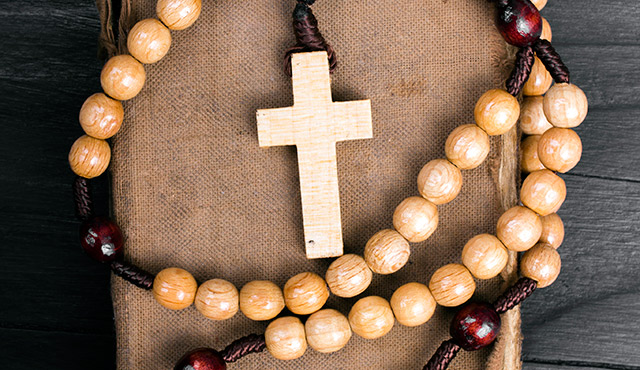Because of the vitality of the rosary as a potent focus for prayer and in recognition of the importance of its recitation as a cherished devotional act, October has been designated by the Church as the Month of the Rosary.
Derived from Latin, rosary translates to a garland of roses, which is the flower that often symbolizes the Virgin Mary. The feast of Our Lady of the Rosary, on Oct. 7, was first established by Pope St. Pius V to honor Mary for the victory over the Turks at Lepanto in 1571.
Although an account in 1206 is often accepted as a legend, Mary is said to have appeared to Saint Dominic and presented him with a gift of the rosary to explain its use as a powerful weapon of prayer.
“Since the prayers of the rosary come from such excellent sources — from Our Lord Himself, from inspired Scripture, and from the Church — it is not surprising that the rosary is so dear to our Blessed Mother and so powerful with heaven,” writes internationally-acclaimed theologian Father William G. Most in his book “Mary in Our Life.”
In 2002, Pope John Paul II further emphasized the significance of the rosary when he added the Luminous Mysteries of the Rosary, which center on Christ’s public life.
Often referred to as “The Rosary Pope,” Pope Leo XXIII wrote 12 encyclicals and five apostolic letters that focused on the theme of the rosary. Between 1883 and 1898, nearly every year, a new encyclical of the rosary was added to prepare for the month of October.
It was Pope Francis who articulated a clear and beautiful meaning of the rosary when he wrote in the Italian edition of a book on Marian prayer, “The rosary is a prayer that always accompanies me; it is also the prayer of the ordinary people and the saints… it is a prayer from my heart.”
The efficacy of the rosary and its celebration during the month of October may lie in its humble beginnings, according to Father Felix Just, S.J., the Executive Director of Loyola Institute for Spirituality. He explains that the Prayer of the rosary was developed in place of the complicated “Liturgy of the Hours,” which is based on the psalms during the medieval period.
“It requires some rather thick books to detail the weekly and monthly sequence of psalms, prayers, Scripture readings, and other texts that make up the ‘Liturgy of the Hours,’” says Father Felix. “Thus, the rosary provided a much simpler form of daily prayer, especially for people who could not read or could not afford the big books that contain the ‘Liturgy of the Hours.’”
It was Pope Leo XXIII who passionately held that the rosary was meant to affect society as a whole in addition to its power in one’s spiritual life. His 1893 encyclical emphasized that the rosary could have social effects, writing, “It is mainly to expand the kingdom of Christ that we look to the rosary for the most effective help.”
Over the centuries, there have been numerous advocates for the rosary. Father Felix says, “Several religious orders of the Catholic Church, including the Dominicans and almost any order with Mary in their name: Marists, Marianists, Servites and Carmelites.”
Beyond Catholic leaders, Father Felix adds, “Many groups of lay men and women have also strongly promoted the regular use of the rosary, not only the Blue Army and Sodalities of Mary, but also the Equestrian Order of the Holy Sepulchre of Jerusalem, which asks it members to pray the rosary at least weekly, if not daily.”
Today, the rosary remains a strong devotion among American Catholics. Pope Benedict XVI, during an address at the Basilica of St. Mary Major in 2008, offered these words for Catholics during the Month of the Rosary: “The rosary, when it is prayed in an authentic way, not mechanical and superficial but profoundly, it brings, in fact, peace and reconciliation. It contains within itself the healing power of the Most Holy Name of Jesus, invoked with faith and love at the center of each ‘Hail Mary.’”
Praying the Holy Rosary
- Make the Sign of the Cross.
- Holding the crucifix, say the Apostles’ Creed.
- On the first bead, say an Our Father.
- Say three Hail Maryson each of the next three beads.
- Say the Glory Be.
- For each of the five decades, announce the mystery, thensay the Our Father.
- While fingering each of the ten beads of the decade, next say ten Hail Maryswhile meditating on the mystery. Then say a Glory Be. (After finishing each decade, some say the following prayer requested by the Blessed Virgin Mary at Fatima: “O my Jesus, forgive us our sins, save us from the fires of hell, lead all souls to heaven, especially those who have most need of your mercy.”)
- After saying the five decades, saythe “Hail, Holy Queen,” followed by this dialogue and prayer:
- Pray for us, O holy Mother of God.
- That we may be made worthy of the promises of Christ.
Let us pray: O God, whose only begotten son,
by his life, death, and resurrection,
has purchased for us the rewards of eternal life,
grant, we beseech thee,
that while meditating on these mysteries
of the most holy rosary of the Blessed Virgin Mary,
we may imitate what they contain
and obtain what they promise,
through the same Christ our Lord. Amen.
Source: The United State Conference of Catholic Bishops

